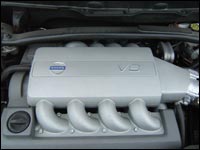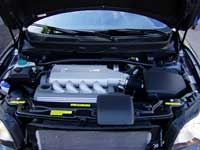


Volvo XC90 V8 2006MY Road Test
27 May 2005
On Par with the Best Premium Imports?
The large luxury SUV has been at the forefront of the horsepower wars consuming most segments of the auto industry these days, and which continue virtually unabated despite the price of crude oil reaching new heights.
Buyers of these vehicles want it all, and the Volvo XC90, in its first three model years, has certainly been one of the more appealing and best-selling premium SUVs, with a rational combination of attributes like safety, conservative luxury and Swedish quality.
Effortless performance was perhaps not that high on the list, although many people would say that a turbocharged six cylinder engine is plenty powerful enough. Still, the XC90 is a relatively heavy vehicle, and it has been playing in an arena that has been populated with V8-powered rivals since before its introduction.
It was only a matter of time before Volvo offered a V8 in one of their models, and the XC90 is a good one for them to start with, as it vaults the SUV up into an entirely different class, where it can run with the base V8s of all the other prestige European marques.
The question for Volvo was, where would the V8 come from, since the brand had never had one? And how could it be made to fit into an engine compartment designed for transverse inline engines, while maintaining the all-important crumple zones?
The connection with company owner Ford was little help, at least as far as its current line-up of V8s goes. But about ten years ago, there was a Ford Taurus called the SHO, and in its last incarnation, it had a transversely-mounted, 60-degree (versus the usual 90) V8. That engine was made by Yamaha, and it was the conceptual inspiration for the Volvo V8, which is also made by the Japanese firm, although the Swedes arent exactly playing up that connection.
The narrower block angle is the solution to both fitting a V8 transversely into the engine bay, and maintaining the all-important safety standards of the XC90. The output is as one would expect for a DOHC 32-valve 4.4-liter engine, with 315 horsepower, and 325 lb-ft of torque at 3,900 rpm, over 80 percent of which is available as low as 2,000 rpm thanks to some creative intake manifold design and variable valve timing.
Volvo claims the new engine is the cleanest gasoline-powered V8 on the market today, meeting the American ULEV II standards, thanks in part to the use of four catalytic converters. It is also one of the most economical, returning 14 mpg in the city and 22 mpg highway.
Volvo put some thought into how the V8 should sound. After all, it is aimed primarily at North Americans who are quite accustomed to big V8s and their macho rumble, but such crassness would hardly be suitable for a classy Euro SUV. The Swedes settled on a muted, yet authoritative sound, with an appealing burble when the throttle is let off. The folks down at the country club wont be offended.
For various reasons including torque management, performance and refinement, a new transmission was a necessity behind the V8, and Volvo has equipped it with an entirely new six-speed automatic, which is as compact as the engine is so it would not interfere with the structure of the vehicle. It is equipped with Geartronic, so that manual shifting is possible.
The third ingredient in the V8 recipe is the electronic all-wheel drive system, which is, as before, of the Haldex type. It has been massaged to allow more engine torque to be "pre-charged" into the system under normal front-wheel drive conditions. When conditions warrant and the rear wheels are called into action, that torque is ready to go sooner, reducing the slippage of the wheels before the system reacts. Not only that, but the amount of power that can be directed rearward has been increased by 50 percent over the previous XC90.
A brief drive in the XC90 V8 showed that the mere adequacies in power and refinement of either of the 5- or 6-cylinder models have been thoroughly addressed. The V8 moves down the road with authority, all with a greater degree of effortlessness and a much nicer soundtrack.
Beyond the mechanical changes, there is little different from the XC90 that has been increasing its sales in most reporting periods even after three years on the market. Although the 2.5T 5-cylinder model remains, the T6 with the turbo six has been discontinued, and the V8 is equipped pretty much the way it was in terms of safety and luxury equipment, which is to say there is nothing lacking.
There is one major option package called "Luxury," which strangely, besides the high-end Dolby audio, has little to do with luxury. Really, a cargo cover is not a luxury item, and one might think that on such a high-end vehicle, such a security necessity would be standard.
More interesting are the stand-alone options, which include 18-inch alloy wheels replacing the standard 17s, third-row seating (a smart move to not make this seldom-used feature standard), DVD navigation, and dual-screen DVD rear entertainment system.
Checking all the options boxes will add $9,710 to the base price of $45,395. The price compares favorably with its European competition, but of course, it makes the XC90 V8 the most expensive Volvo ever.
That should matter little to the target customer, the 55 year-old empty-nester business owner who likes to golf, and is enthusiastic about cars and driving.
As Volvo CEO Hans-Olov Olsson said, "Its important that we can launch a V8 without compromising our core values - high safety and good environmental properties." At that, Volvo has succeeded.
Legal | Privacy | Contact Us | Search | Site Map
Volvo Owners' Club Limited® 1962-2025

